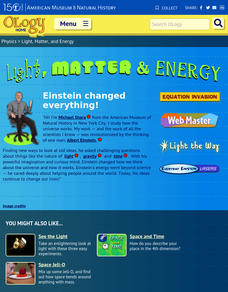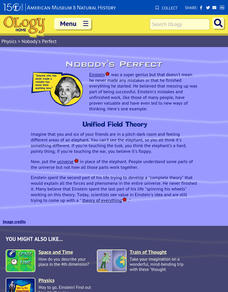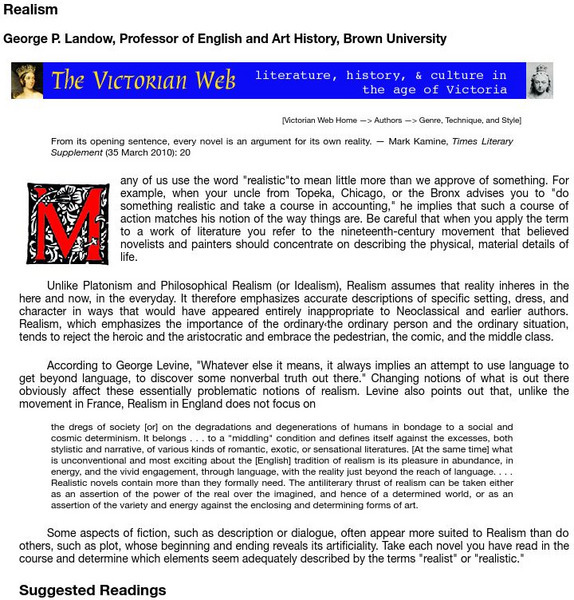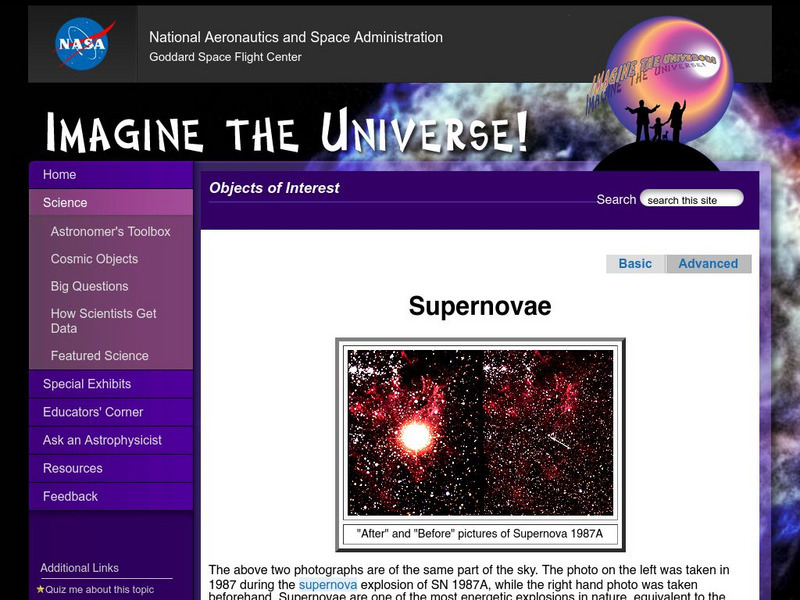American Museum of Natural History
Light, Matter and Energy
Let Einstein's work shine the way. Pupils read about Einstein's iconic equation, E=mc^2, using a remote learning resource and see how ideas from other scientists such as Kepner, Curie, Galilei, and Newton led to its discovery. They...
American Museum of Natural History
Space and Time
Carve out some time to learn about space-time. Young scientists use a remote learning resource to read up on the relationship between space and time. They consider the idea of relativity, see how objects with a large mass can bend space...
American Museum of Natural History
Train of Thought
Hop aboard the train of thought. A remote learning resource has learners consider thought experiments to consider scientific theories. It provides two examples, one on orbiting bodies and the other on the speed of light, for them to work...
American Museum of Natural History
Nobody's Perfect
Even Einstein made mistakes, you know. A remote learning resource explains how scientists are sometimes unsuccessful. Pupils learn about Einstein's failed quest to find a unified field theory that explained the entire universe.
Judicial Learning Center
Your Day in Court
Whether out of choice or necessity, people want to know what will happen on a typical day in court. A helpful lesson walks scholars in the field of criminology through the trial process from opening statements to the final verdict.
Curated OER
Bermuda Triangle
Young scholars explore what the Bermuda triangle is and the theories as to why it is so mysterious. In this mystery lesson students read and discuss the history and the mystery behind the Bermuda Triangle.
US Department of Agriculture
Choose My Plate: Why Is Physical Activity Important?
This site includes a simple list of reasons why getting exercise is important for your physical and emotional well-being. Also, learn definitions and examples of aerobic activities, resistance activities, and stretching activities.
US Department of Agriculture
Choose My Plate: What Is Physical Activity?
This website provides a brief definition of "physical activity" as well as examples of "moderate physical activities" and "vigorous physical activities."
Ducksters
Ducksters: Physics for Kids: Motion Glossary and Terms
Kids learn about glossary and terms in the science of physics and motion. Definitions for words such as momentum, force, work, energy, gravity, scalar, vector, power, and more.
Ducksters
Ducksters: Physics for Kids: Electricity Glossary and Terms
Kids learn about electricity glossary and terms in the science of physics. Words and definitions you need to know such as current, voltage, resistance, and more.
Georgia State University
Georgia State University: Hyper Physics: Geo Physics: Minerals
This is a resource for students to use in their study of minerals. It begins with a general description that includes the list of essential characteristics of a "mineral." Minerals are then grouped alphabetically. Selecting a name...
Symmetry Magazine
Symmetry Magazine: Explain It in 60 Seconds: A Theory
The definition of a theory as it applied to science is explained in this brief article. "Explain It In 60 Seconds" is an article series that aims to summarize in a few paragraphs the meaning of different concepts in particle physics.
Other
Avatar Consultants, Inc: Definition of Intensity
Power, loudness, and decibel levels of sound waves are described and explained. The relative power output of various musical instruments is given.
University of Toronto (Canada)
Harrison/special Theory of Relativity
This page provides an incredibly detailed description of Albert Einstein's Special Theory of Relativity. Definitely an excellent website with great pictures and examples!
Other
Avatar Consultants, Inc: Tuning, Scales, and Temperament
A discussion of the composition of complex sounds produced by a musical instrument. Good illustration of how music is applied to physics. Quite a bit of good information, several pages linked together with good definitions as well as...
Victorian Web
The Victorian Web: Realism
This Victorian Web site defines realism as used in literature and as a "nineteenth-century movement that believed novelists and painters should concentrate on describing the physical, material details of life."
NASA
Nasa: Imagine the Universe: Supernovae (Advanced)
Supernovae are divided into two basic physical types, including a description of supernova types and how they are classified based on the existence of hydrogen spectral lines. Definitions of key terms are provided.
Other
Stony Brook Center for Nuclear Theory: Nuclear Theory Group
This site describes the ongoing work by the Stony Brook Center for Nuclear Theory in the field of Quantum Chromodynamics, and gives a brief definition of this concept. The site has a link to the webpage of the primary research scientist.
Boston College
Boston College: Facts on Compulsive Eating
Here, you can read a definition of compulsive eating disorder as well as click on links to read about binge-eating danger signals and physical complications.
















